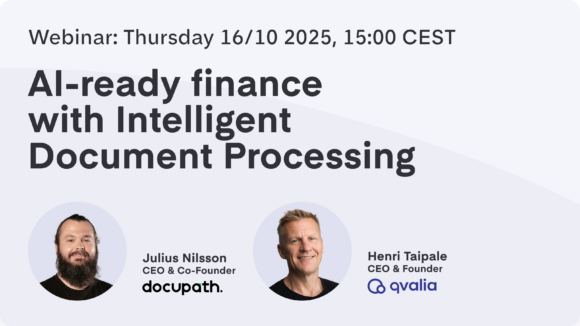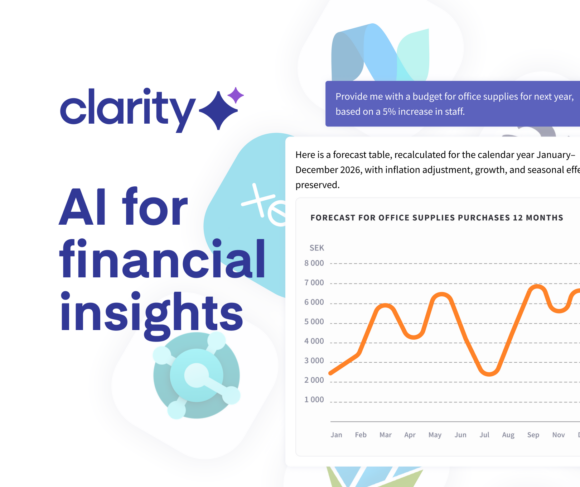AI has moved from theory to reality — and few areas are better positioned to benefit than finance. From accounting and transaction management to procurement, finance processes are data-driven, handle large volumes, and are business-critical.
It is no surprise that organizations are now increasingly experimenting with how AI can be used in these processes. Few doubt that AI has the potential to reshape financial, procurement, and related tasks far more deeply than any previous technological shift.
AI is only as effective as the data it works on. Organizations with structured and normalized accessible data will be the first to capitalize, while those without have a much longer journey to implement AI effectively and qualitatively.
To understand the opportunity, let’s look at how AI has evolved in finance and where it may be headed.
The evolution of AI in finance
Although often seen as new, AI has roots in the earliest days of computing. Visionaries such as Alan Turing and John McCarthy recognized the potential for machines to automate tasks, analyze information, make predictions — and decisions.
Since then, AI has advanced in waves, each era pushing finance further toward automation and intelligence. Four main eras can be distinguished:
1940s–1980s: Early days
The first experiments with expert systems and neural networks marked the birth of AI. In finance, early use cases emerged in credit scoring, fraud detection, and algorithmic trading, but adoption was limited by computing power and data availability.
1990s–2000s: From analog to digital
The shift from paper to digital invoices created the first major leap. ERP systems and e-invoicing pilots enabled automation that reduced manual effort and errors across, for example, the order-to-cash cycle
2010s: Big data and machine learning
The rise of big data enabled more advanced use cases. Finance teams could optimize cash flow, improve forecasting, and base decisions on increasingly large and complex data sets, while machine learning powered anomaly detection and fraud prevention.
2020s–present: The generative AI era
Deep learning and generative AI allow systems to identify patterns and anomalies in massive transaction flows. This enables real-time insights into spend, compliance, and agentic automation.
Future outlook: AI in finance
The long-term vision for AI is artificial general intelligence (AGI) — systems capable of reasoning and adapting much like humans. Whether AGI arrives in a decade or several, it promises to transform every aspect of business and society, finance included.
But the road to AGI is defined by nearer-term breakthroughs that are already transforming financial operations, procurement, and more. These are the technologies leading companies are adopting today.
- Domain-specific models
The shift from generic to specialized AI is accelerating. In finance, this means models that truly understand invoices, contracts, and line-item data — enabling automation and decision intelligence beyond what general tools can provide. - Retrieval-Augmented Generation (RAG)
By combining large language models with a company’s own financial and transactional data, RAG delivers accurate, explainable results. For finance, this means real-time insights without hallucinations. - Context engineering
A growing discipline in AI is how to control and design the context in which an LLM operates. By engineering the information that feeds into the model — such as structured invoices, VAT rules, or supplier data — finance teams can ensure the answers are grounded, accurate, and explainable. Combined with RAG and domain-specific models, context engineering is becoming essential to trustworthy AI in finance.
These developments set the stage for more precise, explainable, and trusted AI in finance. The best part is that businesses can already take advantage of this shift — putting their own data to work for real business impact today.
The present opportunity
This is where Clarity, Qvalia’s financial AI agent, comes in. Clarity connects directly to your structured transaction data to deliver explainable, line-item level insights — without hallucinations. From compliance monitoring to spend analysis, it provides precise answers when you need them.
For finance and procurement leaders, the focus today should be clear. By prioritizing standardized, enriched, and accessible data, businesses can already achieve significant benefits from AI.
Further reading
Learn how to move from concept to execution — and how to prepare your data to unlock the full value of AI. Get practical use cases, opportunities, and strategies for implementing AI across the finance function, in our free whitepaper AI for finance teams.



